What's Happening?
Recent seismic studies have revealed that the Indian Plate is undergoing a complex process of bending, warping, and tearing beneath the Himalayas. This discovery challenges previous geological models that depicted the plate as moving uniformly beneath Tibet. Instead, the plate is breaking into pieces, with some sections peeling away and allowing molten mantle rock to rise. This fragmented movement has significant implications for understanding seismic activity in the region, which is known for its earthquake-prone nature. The findings suggest that the Indian Plate's behavior is more dynamic and complex than previously thought, with sections of the plate sliding under Tibet in a process known as underplating, while other parts are pulled downward by gravity, creating gaps that allow partially molten rock to squeeze in.
Why It's Important?
The tearing of the Indian Plate poses significant risks in an already seismically active region. The process of delamination, where the plate's lower mantle peels away, can increase stress in Earth's crust, potentially triggering stronger and more frequent earthquakes in Tibet and the Himalayas. This is particularly concerning given the proximity of millions of people to these mountains. The research provides crucial evidence of the complex tectonic processes at play, challenging long-held assumptions about continental behavior during collisions. Understanding these processes is vital for improving earthquake hazard assessments and refining models of mountain formation, which can aid studies of other collision zones globally.
What's Next?
Further seismic surveys and chemical analyses are needed to understand how the Indian Plate continues to deform over time. Scientists emphasize that the current data offers only a snapshot of ongoing geological activity. The insights gained from this research have the potential to inform future studies and enhance our understanding of Earth's geological complexities. Improved data may one day allow for more accurate predictions of earthquake risks, helping communities prepare for the powerful forces beneath their feet.
Beyond the Headlines
The discovery of a tearing Indian Plate not only enhances earthquake hazard assessments but also reshapes our understanding of Earth's dynamic processes. By demonstrating that continents can warp and tear, the findings challenge traditional models of tectonic behavior and offer new perspectives on mountain formation and earthquake distribution. This research underscores the global importance of understanding tectonic collisions, as similar processes may have shaped other mountain ranges worldwide.











